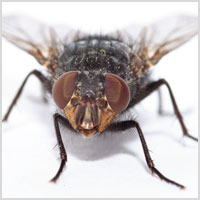House Fly
 Common Name:House Fly
Common Name:House Fly
Scientific Name:Musca domestica
Introduction: The house fly received the common name from being the most common fly found around homes. It is not only a nuisance pest but of concern, and potentially is able to carry diseases or pathogenic organisms. It is worldwide in distribution and is found throughout Britain. Adults are very active fliers and are capable of travelling several miles; they usually breed in rotting or moist organic matter.
Recognition:Houseflies are mostly grey, with 2 vertical black stripes on the thorax and pale yellowish colour on the abdomen. The females are slightly larger than males with sponge-sucking mouthparts for consuming liquids.
Biology: Egg>Lava>Pupa>Adult. The adult female lays several batches of to 150 eggs in rotting or moist organic materials. The eggs are white, oval, and are about 1mm long; eggs are laid singly but usually in clusters of 25 to 50 for a total of 75 to 150 per batch. Hatching may take from 8 to 48 hours after being laid. After the eggs have been hatched legless maggots can be seen on rotting or organic materials. Lava or maggots are about 12mm long and will undergo 3 moults between one to two weeks (range five days to one month or more) depending on conditions and will move away from food source when fully developed. An ideal temperature would consider being between 30-40 degrees. The full grown larva seeks a cool and dry place to pupate; the pupa is reddish brown in colour. It will take about one to two weeks from pupa to adult.Habits:The houseflies are capable of travelling several miles from their release point or larval habitat if sufficient food is available. Females seek almost any warm moist material with sufficient food for larval development for egg-laying purposes. At night they rest on ceilings, walls, electric wires, dangling light cords, edges or corners of buildings and plants. Their night resting places are usually near their daytime food sources. House flies are general feeders, being attracted to a wide variety of substances from excrement to human foods. Because of their sponging mouthparts, they can feed only on liquids. They eject saliva onto solid food which then sucks up with their proboscis. House flies are found in piggeries, stables, poultry houses, refuse sites and tips, homes and dead carcases. Also, a house fly excretes and regurgitates whenever it comes to rest. This habit, coupled with its many body hairs and bristles and the sticky pads at the base of the claws on each leg make them well adapted for transporting disease organisms.
Potential harm: House flies are known to transmit diseases causing pathogens. Such pathogens include those causing typhoid fever, cholera, diarrhoea, dysentery, tuberculosis, anthrax, ophthalmia, polio, and salmonellosis, as well as parasitic worms. They have been shown to be diseased pathogen transmitters by their vomit, faeces, and contaminated external body parts.
Control :Housefly control includes inspection, sanitation, mechanical control, and insecticide application. Physical control methods should be first used in order to get rid of house flies (removal of food source) in a particular location if possible. Approved insecticides, electronic fly killers (EFK), sticky paper can be used to control the remaining lava, and adult. House flies can also be controlled by good sanitation or hygiene practice for e.g. in stables, poultry houses, piggeries, restaurant, domestic houses etc. We can assist you in all matters of London pest control.




























